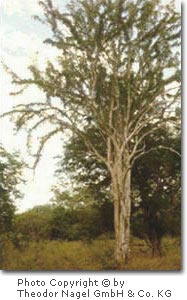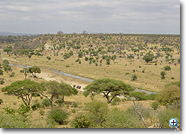
The grenadilla wood (binomial name: Dalbergia melanoxylon, Leg.-Papilionaceae) has various names around the world. In Africa, his country of origin, it is called mainly "Mpingo". In the English-speaking world it is called "African blackwood" or "grenadilla", in French it goes under the name of "grenadille d’Afrique" or "ébène mozambique", the Portuguese know it as "pão preto" (black wood) and in German-speaking countries it is
termed "Grenadill".
In 1502 the Portuguese seafarer Vasco da Gama brought grenadilla from Mozambique back to his country as a replacement for the costly genuine Asian ebony (Diospyros spp., Ebenaceae). It therefore
often happens that grenadilla is erroneously referred to as ebony. But ebony is a hard, dry, brittle wood with a very low oil and resin content, and thus it is now scarcely used for making woodwind instruments.
At this juncture one should also mention cocuswood (Brya ebenus), well known on account of its aesthetically pleasing appearance and belonging to the same family (Leg.-Papilionaceae) as grenadilla.
Because of the highly intensive exploitation of this already rare type of wood, imports have become a great rarity. Cocuswood is a dry wood with a low oil content, so it cracks easily, and because of its components it can produce extreme
allergic reactions..
Still the Grenadilla wood remains the first choice for oboes, clarinets and flutes. Especially because of its waterproof and sound outstanding qualities. In the production of my flutes I refrain from using cocuswood, kingwood and other
exotic, aesthetically beautiful timber. On the basis of my many years of experience I can only confirm that grenadilla is the most suitable wood for woodwind instruments.

The trunk of the grenadilla tree is made up of the dead heartwood and the living sapwood, the colours of which are sharply differentiated. The layer of sapwood is very thin and yellowish, and as it is worthless for instrument-making it is
removed when the tree is felled.
The backbone, and thus responsible for the tree's stability, is the trunk's heartwood. It is extremely hard, and metabolic waste products are stored in it. It is thus rich in constituent substances, resins and oils - the so-called heartwood
substances - that determine the colour and structure of the wood and are dependent on the soil properties of the location in question. The colour is brownish-violet to black and the pores are medium-sized, scattered and almost completely
full of dark heartwood substances, so that the surfaces seem almost pore-free.
The heartwood is extremely hard, very dense and heavy, and because of its specific gravity of 1.3 g/cm3 it does not float. Drying of grenadilla hardly causes any shrinkage.
As a result of its solidity, oil content and close grain - facilitating smooth surface treatment - grenadilla scarcely absorbs any moisture from its surroundings, and being the heaviest, densest, most water‑resistant wood it is thus
absolutely ideal for woodwind-instrument making.
However, the selection and processing of the wood call for broad knowledge and experience.
Flutes made of African blackwood (grenadilla) have a "full tone which is particularly attractive in the high register" (Theobald Boehm).
Their characteristic timbre is bright, resonant, clear, elegant and rich in overtones.
![]() For my flutes and piccolos I use only carefully-selected, well-seasoned, extremely close-grained and attractive black grenadilla with the best
tonal qualities.
For my flutes and piccolos I use only carefully-selected, well-seasoned, extremely close-grained and attractive black grenadilla with the best
tonal qualities. ![]()

The grenadilla tree is chiefly to be found in Central and Eastern Africa, especially in Tanzania and Mozambique. It is a tree of the dry forests and the savannah, and grows to a height of about 5-8 m, whereby the trunk diameter of adult
trees is up to around 50 cm and is free of branches. The grenadilla tree grows in isolation, rather scattered with very large intervals between the individual trees and has a ring-shaped crown. Its branches are thorny. Grenadilla is
self-pollinating, and because of the sparse stands it can freely develop.
Because of the region's long dry periods, which the grenadilla tree effortlessly survives, the areas of growth are sparsely populated.
Because the grenadilla trees grow very slowly and because of the current increasing consumption, both by the local population and by the explosive rise in mass production of musical instruments in the Far East, it has already come to
serious bottlenecks in the supply with grenadilla wood. Through this high demand for this timber it came in many places on illegal deforestation.
Some organizations have made the goal to protect nature, to curb illegal logging and to operate only sustainable forest management.
Supplies for our lumberyard stock is obtained solely from verifiably legal forest managements!

The CITES CoP 2017 conference held 2016 in Johannesburg decided to put a large number of timber under the comprehensive protection of CITES Annex II of the Washington Convention.
The classification is due in response to years of pillage and illegal trade. In the future, the production and trading of valuable wood varieties will be made at the legal level. As a manufacturer, we are obliged in the future to keep
records of every instrument and every piece of wood.
What impact does the new arrangement have on the musicians?
For the pure property, except for the invoice, no special proof documents are required.
Invoice / verification document: The invoice must be kept for verification.
Customers who purchased an instrument from us before the start of the new regulation (before 2017/01/02) can prove this by the date of the invoice (as a pre-acquisition product).
For instruments purchased after January 1st 2017, we issue an invoice with detailed information that indicates that CITES II legal wood has been used.
No further documents are required by the customer.
Sales within the EU:
If you would like to resell your instrument, so a proofed document is recommended. This is generally the invoice or a confirmation from the instrument builder ("declaration of materials") which confirms the instrument ID number,
construction year and the use of legal CITES II wood.
In the absence of validation, the customs or the local competent authority may confiscate products when they are offered for private sale.
Traveling within the EU:
No arrangements are to be made for travel within the EU.
Traveling to non-EU countries / Customs problems:
During the trip in a non-EU country is permitted without the submission of BfN documents, which include the wood (Dalbergia melanoxylon / Grenadill). This exception applies only for:
"Non-commercial trading with a maximum weight of 10 kg per shipment"
(CITES Annex II, footnote: #15, point b).
In our cases, the weight of the wood is per instrument: at flute piccolo 60g/0.06kg, and wooden flute with H-foot 220g/0.22kg.
To avoid discussions at the customs, it is advisable to carry your invoice and/or a "declaration of materials" by the instrument
maker.
![]() Many questions concerning the application and practice abroad regarding to music instrument and CITES are still open. It is therefore advisable
to inquire about your country of destination.
Many questions concerning the application and practice abroad regarding to music instrument and CITES are still open. It is therefore advisable
to inquire about your country of destination. ![]()
Further information::
External links:
- Official site of the IUCN
- Dalbergia melanoxylon Red List of Threatened Species.IUCN 2006.
- Sound & Fair
- Mpingo Conservation Project
- "ARKive" Videos and images of African blackwood (Dalbergia melanoxylon)
